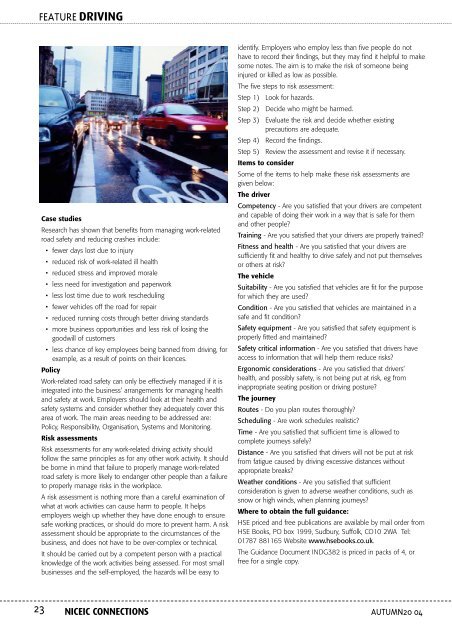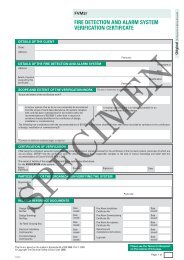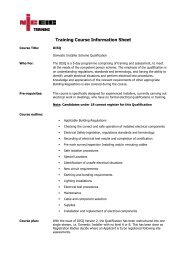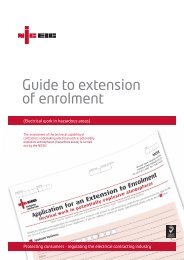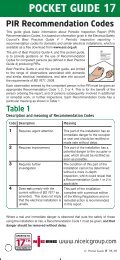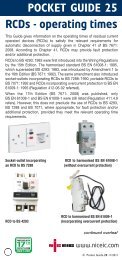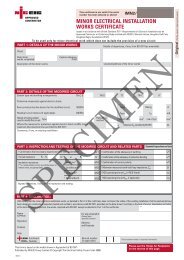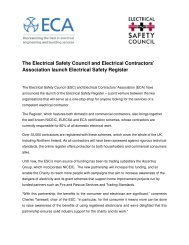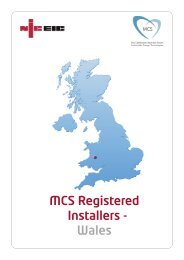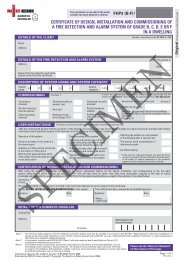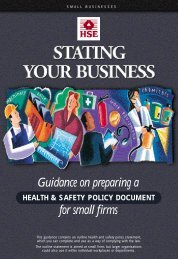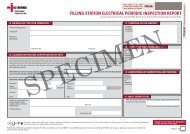PART P - NICEIC
PART P - NICEIC
PART P - NICEIC
You also want an ePaper? Increase the reach of your titles
YUMPU automatically turns print PDFs into web optimized ePapers that Google loves.
FEATURE DRIVING<br />
Case studies<br />
Research has shown that benefits from managing work-related<br />
road safety and reducing crashes include:<br />
• fewer days lost due to injury<br />
• reduced risk of work-related ill health<br />
• reduced stress and improved morale<br />
• less need for investigation and paperwork<br />
• less lost time due to work rescheduling<br />
• fewer vehicles off the road for repair<br />
• reduced running costs through better driving standards<br />
• more business opportunities and less risk of losing the<br />
goodwill of customers<br />
• less chance of key employees being banned from driving, for<br />
example, as a result of points on their licences.<br />
Policy<br />
Work-related road safety can only be effectively managed if it is<br />
integrated into the business’ arrangements for managing health<br />
and safety at work. Employers should look at their health and<br />
safety systems and consider whether they adequately cover this<br />
area of work. The main areas needing to be addressed are:<br />
Policy, Responsibility, Organisation, Systems and Monitoring.<br />
Risk assessments<br />
Risk assessments for any work-related driving activity should<br />
follow the same principles as for any other work activity. It should<br />
be borne in mind that failure to properly manage work-related<br />
road safety is more likely to endanger other people than a failure<br />
to properly manage risks in the workplace.<br />
A risk assessment is nothing more than a careful examination of<br />
what at work activities can cause harm to people. It helps<br />
employers weigh up whether they have done enough to ensure<br />
safe working practices, or should do more to prevent harm. A risk<br />
assessment should be appropriate to the circumstances of the<br />
business, and does not have to be over-complex or technical.<br />
It should be carried out by a competent person with a practical<br />
knowledge of the work activities being assessed. For most small<br />
businesses and the self-employed, the hazards will be easy to<br />
identify. Employers who employ less than five people do not<br />
have to record their findings, but they may find it helpful to make<br />
some notes. The aim is to make the risk of someone being<br />
injured or killed as low as possible.<br />
The five steps to risk assessment:<br />
Step 1)<br />
Step 2)<br />
Step 3)<br />
Step 4)<br />
Step 5)<br />
Look for hazards.<br />
Decide who might be harmed.<br />
Evaluate the risk and decide whether existing<br />
precautions are adequate.<br />
Record the findings.<br />
Review the assessment and revise it if necessary.<br />
Items to consider<br />
Some of the items to help make these risk assessments are<br />
given below:<br />
The driver<br />
Competency - Are you satisfied that your drivers are competent<br />
and capable of doing their work in a way that is safe for them<br />
and other people<br />
Training - Are you satisfied that your drivers are properly trained<br />
Fitness and health - Are you satisfied that your drivers are<br />
sufficiently fit and healthy to drive safely and not put themselves<br />
or others at risk<br />
The vehicle<br />
Suitability - Are you satisfied that vehicles are fit for the purpose<br />
for which they are used<br />
Condition - Are you satisfied that vehicles are maintained in a<br />
safe and fit condition<br />
Safety equipment - Are you satisfied that safety equipment is<br />
properly fitted and maintained<br />
Safety critical information - Are you satisfied that drivers have<br />
access to information that will help them reduce risks<br />
Ergonomic considerations - Are you satisfied that drivers’<br />
health, and possibly safety, is not being put at risk, eg from<br />
inappropriate seating position or driving posture<br />
The journey<br />
Routes - Do you plan routes thoroughly<br />
Scheduling - Are work schedules realistic<br />
Time - Are you satisfied that sufficient time is allowed to<br />
complete journeys safely<br />
Distance - Are you satisfied that drivers will not be put at risk<br />
from fatigue caused by driving excessive distances without<br />
appropriate breaks<br />
Weather conditions - Are you satisfied that sufficient<br />
consideration is given to adverse weather conditions, such as<br />
snow or high winds, when planning journeys<br />
Where to obtain the full guidance:<br />
HSE priced and free publications are available by mail order from<br />
HSE Books, PO box 1999, Sudbury, Suffolk, CO10 2WA Tel:<br />
01787 881165 Website www.hsebooks.co.uk.<br />
The Guidance Document INDG382 is priced in packs of 4, or<br />
free for a single copy.<br />
2 3<br />
<strong>NICEIC</strong> CO N N ECTIONS AUTUMN 20 04<br />
For all enquiries about the <strong>NICEIC</strong> Domestic Installer Scheme, freephone 0800 013 0900


